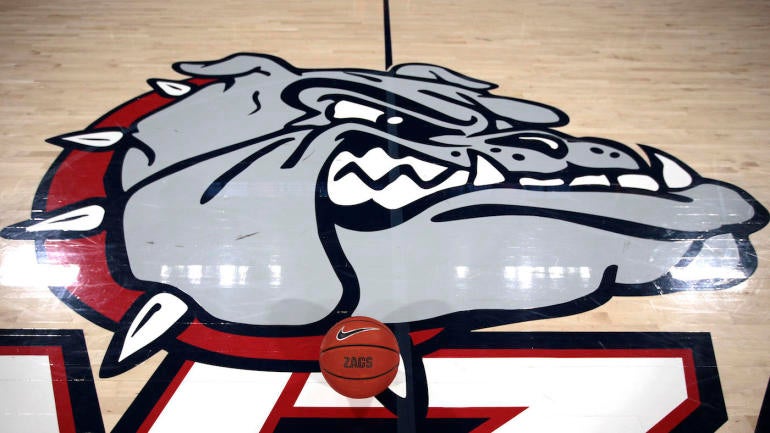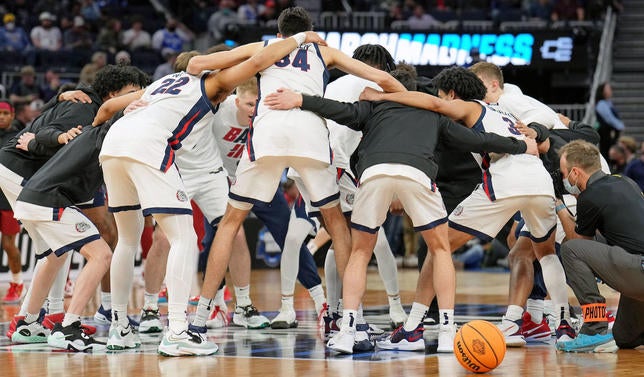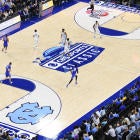
It's unclear how or why the latest (and fleeting) Gonzaga-to-Big-East? rumor surfaced late last week, but for a day or two there was some confusion about whether something was brewing. It's not. Multiple sources reiterated to CBS Sports that nothing material is happening between the two entities, at least for now.
But let's talk about Gonzaga, because the school could soon be in a worse circumstance than it's been in the past decade. It's in these past 10 years that Gonzaga has promoted its position nationally and sustained viability as a powerhouse. The Bulldogs are coming off their 23rd consecutive NCAA Tournament appearance; that ranks behind only Kansas (32) and Michigan State (24) for the longest streak in men's college basketball. The Zags have made seven consecutive Sweet 16s, best among all schools in men's college hoop, and nabbed a No. 1 seed in five of the past nine tournaments. Their average finish at KenPom.com the past 10 seasons: 7.4, easily the best.
By any objective measure, Mark Few is overseeing a top-five program and has been for years. The only thing missing is an NCAA championship ... and potentially an improved scheduling template. Maybe these things are connected.
Gonzaga has been bolstered in recent years by BYU's inclusion in the West Coast Conference, which happened in 2011. In 2023 the Cougars will head to the Big 12. The WCC won't be able to replace BYU with a program nearly as good. As things stand now, Gonzaga could lose two or three crucial Quad 1-level games in its league. Elsewhere in the WCC, San Francisco just had its best season in a generation ... and its coach left for Florida. Saint Mary's is still a worthy foil, but beyond the Gaels, there's no assurance the WCC will be stronger moving forward than it's been since BYU joined. The WCC's average rank as a league, per KenPom, since BYU joined: 10th out of 32. In the 15 years prior to BYU joining, it ranked 13th.
After falling short of a national title for a second straight season, Few is not going to turn idle and accept GU's situation in the WCC while BYU is packing its boxes. I wouldn't 100% rule out Gonzaga one day joining the likes of the Big East, but it's not imminent and on many levels it's not practical.
So, what about this: a nonconference scheduling alliance between Gonzaga and the Big East. If the Big East can't offer more than a pair of games, then maybe Gonzaga goes bigger and tries to do a two-fer with the Big East and the Big 12. It would serve all parties and improve college basketball's product. It sure as hell would make January and February more compelling. What Notre Dame and the ACC are to football, Gonzaga and the Big East (and/or Big 12) could be to college hoops. Why those two leagues? The Big East will soon have the fewest members (11) of any power conference. The Big 12 will soon go from 10 to 12 (and might be at 14 for two lame-duck seasons with Oklahoma and Texas), but it's likely to be a more amenable partner than the Pac-12.
If you're wondering why Gonzaga to the Pac-12 is a non-starter, two reasons: 1) Gonzaga doesn't have football 2) Gonzaga joining the Pac-12 would make Gonzaga at worst the No. 3 program in that league. A lot of schools would be negatively impacted by Gonzaga's inclusion because the only thing the likes of Washington, Washington State, Oregon State, Cal, etc. have over Gonzaga right now -- the only thing -- is their Pac-12 affiliation. Sources said that the Pac-12 has never even informally considered adding Gonzaga, based on the premise that more than half the league would likely be an auto-no on an invite.
As for the Mountain West, the jump isn't considered good enough to be worth the move for the Zags. Ken Pomeroy told CBS Sports he did research for Gonzaga in 2018 and compared what Gonzaga's rating would have been in the Mountain West based on the previous three seasons worth of data vs. what Gonzaga actually did in the WCC in that same span.
"It came out pretty close," Pomeroy said. "I think in that analysis, it might (have) been just a bit more tilted for the Mountain West, which came out narrowly ahead."
This leaves Gonzaga in a catch-22. Great enough to have established its bona fides as a nonconference opponent, but lacking enough national appeal (this is where not having football hurts) to validate being a value-add from a financial standpoint.
"Gonzaga's dilemma is, sure, the Big East would love to have Gonzaga for basketball — but you don't want all the rest," one industry source told CBS Sports. "If you're the WCC, you don't want all the rest and not basketball."
Gonzaga carries 18 scholarship sports. The men's basketball program funds the entire athletic department. It would permanently operate in the red (potentially severely in the red) if it joined a league with a geographic footprint as drastic as the Big East. Having the golf, soccer and tennis teams fly to play St. John's and Providence isn't sensible. More context to consider: The Big East's television contract with Fox goes through 2025. Over the next year, the pre-negotiation stage for the next deal will develop behind the scenes. Big East teams currently make around $4 million annually off that deal.
The resolution going forward for Gonzaga, if it can pull it off, is to adopt a Notre Dame-type of scheduling model. It could financially benefit, perhaps get a small piece of a restructured Big East deal, and enhance its standing nationally in the process.
In football the situation is a bit different, of course. The ACC wants Notre Dame. Desperately. It would practically restructure its conference bylaws if it could get the Irish to leave independency and join the ACC as a full-time football member. Shy of that, Notre Dame is slotted into five games on average each year against ACC schools. It's working out well for both. In basketball, Gonzaga can't bring as much cachet as Notre Dame, but it can bring a team that regularly is competing for No. 1 seeds. That should carry appeal for any league looking for an extra dash of marketability in January and February.

The idea may seem unconventional now, but it would actually be a return to form. For more than 50 years high-profile teams played other nationally relevant non-league games in January and February to break up the slog of the league slate. This wasn't an occasional thing; it was a feature of college basketball's schedule. Arkansas vs. UNLV, Duke vs. St. John's, Duke vs. UCLA, Kentucky vs. Syracuse, UCLA vs. Louisville, UConn vs. Stanford, Arizona vs. Cincinnati and on and on and on for years and years and years.
That's now mostly gone, except for the terrific end-of-January Big 12/SEC Challenge. For Gonzaga, it doesn't even have to always be against the very best Big East/Big 12 teams -- just good programs. Cycle them in and have contracts that stipulate Gonzaga would play two of the five or six best teams from the previous season's standings. With Gonzaga's 16-game WCC schedule, this would easily allow it to play four total nonconference games in January and February. It would be great for college basketball if the Zags were able to spice up the TV slate in a given year with January games at home vs. Villanova, then at BYU. In February, a pair of tilts, say: on the road to play Marquette, then welcome in Baylor for a Gonzaga home game around Valentine's Day.
Come mid-January, when college football season is over and basketball becomes more prominent in our everyday sports conversation, there is a tremendous opportunity for increased value with nonconference matchups between established powers. These games would carry more prominence and attention than the majority of nonconference games that populate November and early December.
Some believe doing this kind of alliance with two leagues would be difficult to maneuver. If it's just the Big East, then have it be three non-league games. Maybe it's UConn, Creighton and Butler in one year. One home, one road, one neutral. Villanova, Xavier, Marquette the next using the same model. It would add attraction and interest to the Big East while providing a significant boost to Gonzaga's brand. The Bulldogs would shed the stigma (fair or not) of traipsing through the WCC before resurfacing in March. It's hard to argue that playing against tougher competition more frequently deeper into the season wouldn't be a good thing. Yes, it would be a detriment to Gonzaga's chase of No. 1 seeds, but the challenge surely must be worth that risk for Few's program.
For Gonzaga, this could be the catalyst to continue its evolution as a national power. The school can't do it on its own, but perhaps coaches and athletic directors and conference commissioners will look around and realize there are still opportunities to improve the sport's marketability prior to March. Capitalize on it. Lean into the Gonzaga story; the Big East or Big 12 might see its teams as the ones that benefit most from this.
How great would a Gonzaga/Villanova home-and-home be in February? Gonzaga vs. Kansas on a Monday in the middle of January? Plenty of college sports fans would sign up for that kind of calendric creativity, which would be a refreshing return to how the TV schedule used to look — before the conferences bloated, the TV contracts restricted flexibility and multi-team events populated the early portion of the season so much that it made scheduling into January and February nearly impossible.
But it's not impossible. This can be done if the right people think about this the right way. What was old can be new again. If there was ever a program to experiment with this, Gonzaga is the perfect choice.


















